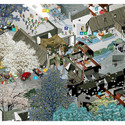[ilya
few years architectural Association in London held an exhibition entitled first Works: Emerging architectural experimentation in the 1960s and 1970s, attended perfectly together first of many projects the most famous names in architecture. In the animated beautifully shot two Zaha Hadid / prospects of the residence of the Taoiseach and intensely unstable drawings of Daniel Libeskind Micromegas, you can already feel a formal exploration of life ahead for the pair; and yet never guess the single tectonic speaking anonymously ahead of mundane drawings by Morphosis Sequoyah Educational Research Centre?
When I set up the architecture Graduate Scholarships (Global GAGAS) in The Architectural Review in 2012, he was with the idea that, at its best, work product at the beginning of his career can be bolder and projective. At this fruitful line between academia and practice, graduates may be uncertain years to come more assured and mature colleagues in the creative risks they are willing to take.


assembly_of_suburbia.jpg?1406067449)
 10
10
what happens to our students design work after we graduate? Many of our portfolios undoubtedly end up languishing forgotten under the bed, or relegated to the attic like a crazy old Mrs Rochester, or - more recently - frozen inaccessibly on unlicensed software. When dug up again decades later, they come back to our elders themselves familiar yet foreign, like hearing your own voice on a recording, and perhaps equally disconcerting. For some, the work produced as a student defines the trajectory of a career; for others, it marks a nadir from which they run as fast as their legs will carry them - and perhaps for most of us, it is a strange mixture of both, a paradox embedded and disowned
in the case of Hadid and Libeskind, these early efforts may end up defining a generation. And even - of course - several generations to follow :. It is not uncommon to see the reasons for such precursors, so fresh at the time resurface in student projects to date, such as a virus outbreak unshakable
therefore, the ambition for GAGAS was to find students actually try to push culture forward architecture to provide an international platform for shooting concerns to speculation of world architecture graduate, and to get an idea of where the discipline could be heading in the future.
the first two years have shown that the answers to this are both wide and divergent. Last year, for example, the winner of the third cycle Frances Edith Cooper (Auckland University) presented a reimagining episodic charming and whimsically illustrated Waitemata Harbour in New Zealand; while earning undergraduate Cristian Allende (University of Talca, Chile) built a viewing platform soaring among the foothills of the mountain range of Rio Los Cipreses. While the first project was concerned with the craft drawings, the second project was concerned with the craft of building itself. And yet, despite their very different design intent, the two projects have shown similar respect for and affinity with nature.
If there was an underlying theme for the first two years of the GAGAS, there is a desire to live in harmony with the Earth a reflection of the many ways that this generation of students interprets the environmental agenda of our time.
will this trend continue? It is too early to say for GAGAS this year, as there is a week or two to go before the closing deadline. Certainly, as a citizen of the world, I would like to see sustainability embrace architecture as a central rather than incidental to its culture; but as president of the jury of GAGA, I keep a completely open mind about the surprises that can present cohort. And who knows, among them could be the next Hadid and Libeskind, radiation in directions we had not imagined and ready to put on the agenda for a generation to come.
The architecture of global grants graduate has a £ 5,000 prize fund. The registration deadline is Monday, August 4 For complete information visit www.architectural-review.com/
Will Hunter is The Architectural Review editor, and director of the London School of Architecture
Posting Komentar